Tertiary consumers Study guides, Class notes & Summaries
Looking for the best study guides, study notes and summaries about Tertiary consumers? On this page you'll find 899 study documents about Tertiary consumers.
Page 2 out of 899 results
Sort by

-
WVU Biology 101 Final: Salihu Latest Update Already Passed
- Exam (elaborations) • 15 pages • 2024
- Available in package deal
-
- $9.99
- + learn more
WVU Biology 101 Final: Salihu Latest Update Already Passed Hypothesis A proposed, scientifically testable explanation for an observed phenomenon. Theory A hypothesis that has been tested with a significant amount of data Features of a well designed experiment 1. Repeatable 2. Multiple Treatments 3. Testable Variables 4. Control Group 5. Replication Blind experiment The subjects do not know what treatment they receive Double-blind experiment An experiment in which both the o...

-
Nln - ? Practice Test Science Pax Exam All With Complete Solutions Latest Update
- Exam (elaborations) • 82 pages • 2024
-
- $14.49
- + learn more
An organism with chloroplast in its cell is probably a autotroph autotrophs are organisms that produce their own food from inorganic substances, plants are autotrophs heterotrophs obtain their food by consuming plants or other animals. They are also referred to as consumers. Primary consumers may be herbivores herbivores plant eaters omnivores plant and meat eaters Secondary consumers are carnivores, meat eaters, or omnivores that eat herbivores. Tertiary consumers are carnivor...
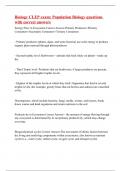
-
Biology CLEP exam: Population Biology questions with correct answers
- Exam (elaborations) • 12 pages • 2023
-
- $13.99
- + learn more
Energy Flow in Ecosystem Correct Answer-Primary Producers>Primary Consumers>Secondary Consumers>Tertiary Consumers - Primary producers (plants, algae, and some bacteria) use solar energy to produce organic plant material through photosynthesis. - Second trophic level: Herbivores—animals that feed solely on plants—make up the. - Third Tropic level: Predators that eat herbivores; if larger predators are present, they represent still higher trophic levels. - Highest of th...

-
ENWC 201 Final Exam Review Questions And Answers
- Exam (elaborations) • 19 pages • 2024
-
- $13.49
- + learn more
ENWC 201 Final Exam Review Questions And Answers Definition of Wildlife - ANS all non-domesticated plants, animals and organisms Definition of conservation - ANS act of conserving or saving something Gifford Pinchot and his contribution to wildlife conservation - ANS Founder of US forest service. Studied in Europe *forest as a resource and conservation. Coined the term conservation Definition of Ecology - ANS the study of organisms interacting within their enviro...

-
WILDLIFE FINAL EXAM QUESTIONS AND ANSWERS
- Exam (elaborations) • 14 pages • 2024
- Available in package deal
-
- $12.49
- + learn more
What is an animal's niche? How many dimensions can a niche have? Can animals share a niche? - Answer-•the functional role/job of an organism considered in the environment it lives in •many dimensions, but can be divided to 3: the ecological 'space' it fills, and the physical space it literally fills and time when they do •no animals can share the same niche! What is a specialist vs a generalist? - Answer-•specialist: narrow niche, limited diet, restricted to a particular location...
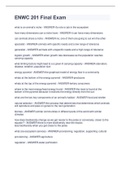
-
ENWC 201 Final Exam with correct ANSWERS 2022
- Exam (elaborations) • 9 pages • 2022
-
- $8.49
- 1x sold
- + learn more
what is an animal's niche - ANSWER-it's role or job in the ecosystem how many dimensions can a niche have - ANSWER-it can have many dimensions can animals share a niche - ANSWER-no, one of them are going to out win the other specialist - ANSWER-animals with specific needs and a low range of tolerance generalist - ANSWER-animals with unspecific needs and a high range of tolerance logistic growth - ANSWER-when growth rate decreases as the population reaches carrying capacity what limiting...
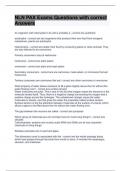
-
NLN PAX Exams Questions with correct Answers 2023/2024
- Exam (elaborations) • 26 pages • 2023
- Available in package deal
-
- $13.99
- + learn more
NLN PAX Exams Questions with correct Answers 2023/2024 An organism with chloroplast in its cell is probably a - correct ans autotroph autotrophs - correct ans are organisms that produce their own food from inorganic substances, plants are autotrophs heterotrophs - correct ans obtain their food by consuming plants or other animals. They are also referred to as consumers. Primary consumers may be herbivores herbivores - correct ans plant eaters omnivores - correct ans plant and me...
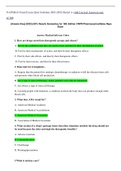
-
NAPSRx® Final Exam Quiz Solution 2021-2022 Rated A+ 144 Correct Answers out of 160
- Exam (elaborations) • 34 pages • 2022
-
- $30.49
- 29x sold
- + learn more
NAPSRx® Final Exam Quiz Solution 2021-2022 Rated A+ 144 Correct Answers out of 160 [Answer-Key] [2022] (92% Result) Answer key for 16th Edition CNPR Pharmaceutical Sales Reps Exam Answer Marked in Green Color 1. How are drugs sorted into therapeutic groups and classes? A. first by the conditions that they are used to treat. and then by their mechanisms of action B. First by their mechanisms of action. and then by their therapeutic effects C. First by their side effects. and ...

-
Bio 106 Ecology Questions and Answers Already Passed
- Exam (elaborations) • 7 pages • 2024
- Available in package deal
-
- $9.99
- + learn more
Bio 106 Ecology Questions and Answers Already Passed What is a "community"? A group of many species organized by interactions What interactions structure the community? Mutualism, Consumption, Competition Who gets harmed, who benefits in each type of interaction? Mutualism- both benefit Consumption- one species benefits, other is harmed Competition- both species harmed, one more than the other How do these interactions create an interdependence underlying community structure? ...
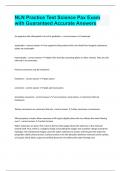
-
NLN Practice Test Science Pax Exam with Guaranteed Accurate Answers
- Exam (elaborations) • 36 pages • 2024
-
- $13.49
- + learn more
An organism with chloroplast in its cell is probably a - correct answer autotroph autotrophs - correct answer are organisms that produce their own food from inorganic substances, plants are autotrophs heterotrophs - correct answer obtain their food by consuming plants or other animals. They are also referred to as consumers. Primary consumers may be herbivores herbivores - correct answer plant eaters omnivores - correct answer plant and meat eaters Secondary consumers - correc...

Did you know that on average a seller on Stuvia earns $82 per month selling study resources? Hmm, hint, hint. Discover all about earning on Stuvia


